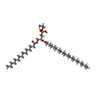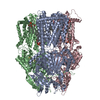+Search query
-Structure paper
| Title | Structural Basis of Peptide-Based Antimicrobial Inhibition of a Resistance-Nodulation-Cell Division Multidrug Efflux Pump. |
|---|---|
| Journal, issue, pages | Microbiol Spectr, Vol. 10, Issue 5, Page e0299022, Year 2022 |
| Publish date | Oct 26, 2022 |
 Authors Authors | Meinan Lyu / Julio C Ayala / Isabella Chirakos / Chih-Chia Su / William M Shafer / Edward W Yu /  |
| PubMed Abstract | Bacterial efflux pumps in the resistance-nodulation-cell division (RND) family of Gram-negative bacteria contribute significantly to the development of antimicrobial resistance by many pathogens. In ...Bacterial efflux pumps in the resistance-nodulation-cell division (RND) family of Gram-negative bacteria contribute significantly to the development of antimicrobial resistance by many pathogens. In this study, we selected the MtrD transporter protein of Neisseria gonorrhoeae as it is the sole RND pump possessed by this strictly human pathogen and can export multiple antimicrobials, including antibiotics, bile salts, detergents, dyes, and antimicrobial peptides. Using knowledge from our previously published structures of MtrD in the presence or absence of bound antibiotics as a model and the known ability of MtrCDE to export cationic antimicrobial peptides, we hypothesized that cationic peptides could be accommodated within MtrD binding sites. Furthermore, we thought that MtrD-bound peptides lacking antibacterial action could sensitize bacteria to an antibiotic normally exported by the MtrCDE efflux pump or other similar RND-type pumps possessed by different Gram-negative bacteria. We now report the identification of a novel nonantimicrobial cyclic cationic antimicrobial peptide, which we termed CASP (ationic ntibiotic-ensitizing eptide). By single-particle cryo-electron microscopy, we found that CASP binds within the periplasmic cleft region of MtrD using overlapping and distinct amino acid contact sites that interact with another cyclic peptide (colistin) or a linear human cationic antimicrobial peptide derived from human LL-37. While CASP could not sensitize Neisseria gonorrhoeae to an antibiotic (novobiocin) that is a substrate for RND pumps, it could do so against multiple Gram-negative, rod-shaped bacteria. We propose that CASP (or future derivatives) could serve as an adjuvant for the antibiotic treatment of certain Gram-negative infections previously thwarted by RND transporters. RND efflux pumps can export numerous antimicrobials that enter Gram-negative bacteria, and their action can reduce the efficacy of antibiotics and provide decreased susceptibility to various host antimicrobials. Here, we identified a ationic ntibiotic-ensitizing eptide (CASP) that binds within the periplasmic cleft of an RND transporter protein (MtrD) produced by Neisseria gonorrhoeae. Surprisingly, CASP was able to render rod-shaped Gram-negative bacteria, but not gonococci, susceptible to an antibiotic that is a substrate for the gonococcal MtrCDE efflux pump. CASP (or its future derivatives) could be used as an adjuvant to treat infections for which RND efflux contributes to multidrug resistance. |
 External links External links |  Microbiol Spectr / Microbiol Spectr /  PubMed:36121287 / PubMed:36121287 /  PubMed Central PubMed Central |
| Methods | EM (single particle) |
| Resolution | 2.89 - 3.08 Å |
| Structure data | EMDB-27399, PDB-8deu: EMDB-27400, PDB-8dev: EMDB-27401, PDB-8dew: |
| Chemicals |  ChemComp-PTY: |
| Source |
|
 Keywords Keywords | MEMBRANE PROTEIN / MtrD complex / multidrug efflux pump / Neisseria gonorrhoeae |
 Movie
Movie Controller
Controller Structure viewers
Structure viewers About Yorodumi Papers
About Yorodumi Papers









 neisseria gonorrhoeae (bacteria)
neisseria gonorrhoeae (bacteria) homo sapiens (human)
homo sapiens (human)